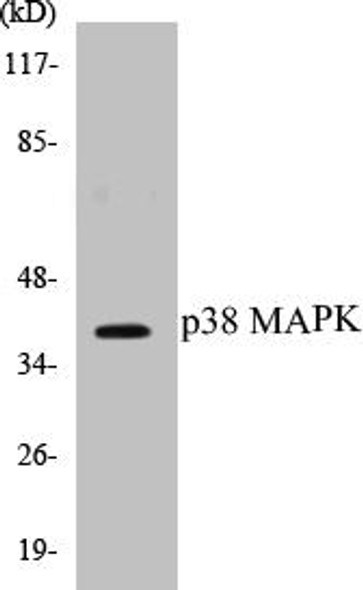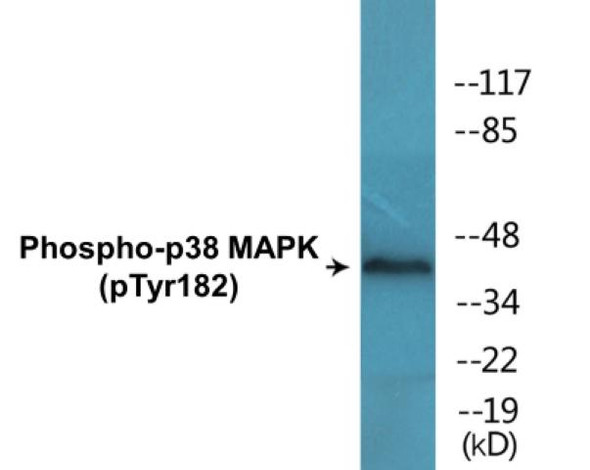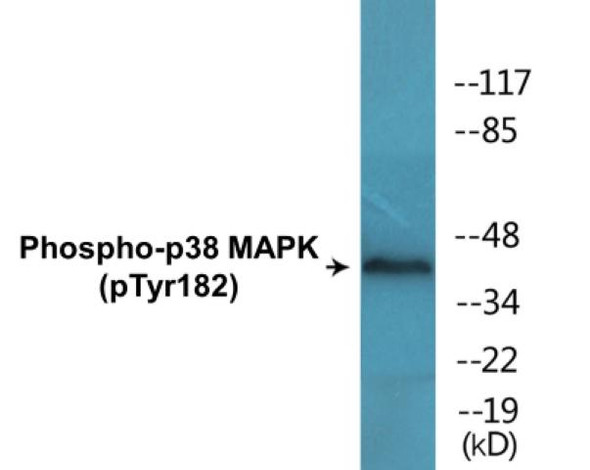Human p38 MAPK ELISA Kit
- SKU:
- HUFI02083
- Product Type:
- ELISA Kit
- Size:
- 96 Assays
- Uniprot:
- Q16539
- Sensitivity:
- 18.75pg/ml
- Range:
- 31.25-2000pg/ml
- ELISA Type:
- Sandwich
- Synonyms:
- MAPK14, SAPK2A, SAPK2a, Mitogen-activated protein kinase p38 alpha, MAP kinase p38 alpha, MAX-interacting protein 2, Cytokine suppressive anti-inflammatory drug-binding protein, CSAID-binding protein, CSBP, MAP kinase MXI2
- Reactivity:
- Human
- Research Area:
- Cell Death
Description
Human p38 MAPK ELISA Kit
Variants of the Aif1 gene has been known to contribute to Autism Spectrum Disorders. A definitive diagnosis of autism requires a DNA testing that can identify Aif1 gene variants or mutations in an individual. Diseases associated with MAPK14 include Chlamydia and Alexander Disease. An important paralog of MAPK14 is MAPK10. The Assay Genie Human p38 MAPK ELISA Kit is a highly sensitive assay for the quantitative measurement of p38 MAPK in serum, blood, plasma, cell culture supernatant and tissue samples.
| Product Name: | Human p38 MAPK ELISA Kit |
| Product Code: | HUFI02083 |
| Size: | 96 Assays |
| Alias: | MAPK14, SAPK2A, SAPK2a, Mitogen-activated protein kinase p38 alpha, MAP kinase p38 alpha, MAX-interacting protein 2, Cytokine suppressive anti-inflammatory drug-binding protein, CSAID-binding protein, CSBP, MAP kinase MXI2 |
| Detection method: | Sandwich ELISA, Double Antibody |
| Application: | This immunoassay kit allows for the in vitro quantitative determination of Human MAPK14 concentrations in serum plasma and other biological fluids. |
| Sensitivity: | 18.75pg/ml |
| Range: | 31.25-2000pg/ml |
| Storage: | 4°C for 6 months |
| Note: | For Research Use Only |
| Recovery: | Matrices listed below were spiked with certain level of Human MAPK14 and the recovery rates were calculated by comparing the measured value to the expected amount of Human MAPK14 in samples. | ||||||||||||||||
| |||||||||||||||||
| Linearity: | The linearity of the kit was assayed by testing samples spiked with appropriate concentration of Human MAPK14 and their serial dilutions. The results were demonstrated by the percentage of calculated concentration to the expected. | ||||||||||||||||
| |||||||||||||||||
| CV(%): | Intra-Assay: CV<8% Inter-Assay: CV<10% |
| Component | Quantity | Storage |
| ELISA Microplate (Dismountable) | 8×12 strips | 4°C for 6 months |
| Lyophilized Standard | 2 | 4°C/-20°C |
| Sample/Standard Dilution Buffer | 20ml | 4°C |
| Biotin-labeled Antibody(Concentrated) | 120ul | 4°C (Protect from light) |
| Antibody Dilution Buffer | 10ml | 4°C |
| HRP-Streptavidin Conjugate(SABC) | 120ul | 4°C (Protect from light) |
| SABC Dilution Buffer | 10ml | 4°C |
| TMB Substrate | 10ml | 4°C (Protect from light) |
| Stop Solution | 10ml | 4°C |
| Wash Buffer(25X) | 30ml | 4°C |
| Plate Sealer | 5 | - |
Other materials and equipment required:
- Microplate reader with 450 nm wavelength filter
- Multichannel Pipette, Pipette, microcentrifuge tubes and disposable pipette tips
- Incubator
- Deionized or distilled water
- Absorbent paper
- Buffer resevoir
| Uniprot | Q16539 |
| UniProt Protein Function: | P38A: a proline-directed ser/thr MAP kinase, and one of four p38 kinases that play important roles in cellular responses to inflammatory cytokines, DNA damage, oxidative stress, and some GPCRs, leading to direct activation of transcription factors and of other downstream kinases including MSK1, MSK2, eEF2K, MK2, and PRAK. MSK1 and -2 play important roles in the rapid induction of immediate-early genes in response to stress or mitogenic stimuli. MK2 and -3 control gene expression mostly at the post-transcriptional level. eEF2K is important for the elongation of mRNA during translation. Ectodomain shedding of transmembrane proteins is regulated by p38 MAPKs as well. In response to inflammatory stimuli, p38 MAPKs phosphorylate the membrane-associated metalloprotease ADAM17, which then cleaves the ectodomain of TGF-alpha family ligands, a process leading to the activation of EGFR signaling and cell proliferation. In the nucleus, many transcription factors are phosphorylated and activated by p38 MAPKs in response to different stimuli. Classical examples include ATF1, ATF2, ATF6, ELK1, PTPRH, CHOPO, p53 and MEF2C and MEF2A. The p38 MAPKs are emerging as important modulators of gene expression by regulating chromatin modifiers and remodelers. The promoters of several genes involved in the inflammatory response, such as IL6, IL8 and IL12B, display a p38 MAPK-dependent enrichment of histone H3 phosphorylation on 'Ser-10' (H3S10ph) in LPS-stimulated myeloid cells. Interacts directly with HDAC3 interacts directly and selectively to repress ATF2 transcriptional activity, and regulate TNF gene expression in LPS-stimulated cells. Phosphorylates the ubiquitin ligase SIAH2, regulating its activity towards EGLN3. May also inhibit the lysosomal degradation pathway of autophagy by interfering with the intracellular trafficking of the transmembrane protein ATG9. Regulates the endocytosis of membrane receptors that depend on RAB5A. Regulates the clathrin-mediated internalization of EGFR induced by inflammatory cytokines and UV irradiation by phosphorylating the EGFR and RAB5A effectors. Required in mid-fetal development for the growth of embryo-derived blood vessels in the labyrinth layer of the placenta. Plays an essential role in developmental and stress-induced erythropoiesis, through regulation of EPO gene expression. Interacts with casein kinase II subunits CSNK2A1 and CSNK2B. Activated by cell stresses such as DNA damage, heat shock, osmotic shock, anisomycin and sodium arsenite, as well as pro-inflammatory stimuli such as LPS and IL-1. Phosphorylated by ZAP70 in an alternative activation pathway in response to TCR signaling in T-cells, a pathway is inhibited by GADD45A. Four alternatively spliced isoforms of the human protein have been observed. Isoform MXI2 activation is stimulated by mitogens and oxidative stress and only poorly phosphorylates ELK1 and ATF2. Isoform EXIP may play a role in the early onset of apoptosis |
| UniProt Protein Details: | Protein type:Protein kinase, CMGC; EC 2.7.11.24; Kinase, protein; Protein kinase, Ser/Thr (non-receptor); CMGC group; MAPK family; p38 subfamily; MAPK/p38 subfamily Chromosomal Location of Human Ortholog: 6p21.3-p21.2 Cellular Component: nucleoplasm; spindle pole; mitochondrion; cytoplasm; cytosol; nucleus Molecular Function:MAP kinase activity; MAP kinase kinase activity; protein serine/threonine kinase activity; protein binding; NFAT protein binding; ATP binding Biological Process: nerve growth factor receptor signaling pathway; activation of MAPK activity; stress-activated MAPK cascade; toll-like receptor 3 signaling pathway; osteoclast differentiation; toll-like receptor 5 signaling pathway; cell surface receptor linked signal transduction; regulation of transcription factor activity; transmembrane receptor protein serine/threonine kinase signaling pathway; chondrocyte differentiation; toll-like receptor 4 signaling pathway; cartilage condensation; platelet activation; mitochondrion organization and biogenesis; skeletal muscle development; transcription, DNA-dependent; positive regulation of blood vessel endothelial cell migration; glucose metabolic process; toll-like receptor 2 signaling pathway; regulation of transcription from RNA polymerase II promoter; muscle cell differentiation; response to muramyl dipeptide; DNA damage checkpoint; striated muscle cell differentiation; positive regulation of transcription from RNA polymerase II promoter; fatty acid oxidation; toll-like receptor 9 signaling pathway; myoblast cell differentiation involved in skeletal muscle regeneration; apoptosis; cell morphogenesis; chemotaxis; signal transduction; toll-like receptor 10 signaling pathway; lipopolysaccharide-mediated signaling pathway; angiogenesis; MyD88-independent toll-like receptor signaling pathway; positive regulation of erythrocyte differentiation; organelle organization and biogenesis; DNA damage response, signal transduction; positive regulation of myoblast differentiation; MyD88-dependent toll-like receptor signaling pathway; peptidyl-serine phosphorylation; positive regulation of protein import into nucleus; Ras protein signal transduction; toll-like receptor signaling pathway; innate immune response; positive regulation of muscle cell differentiation; gene expression; cell motility; vascular endothelial growth factor receptor signaling pathway; blood coagulation |
| NCBI Summary: | The protein encoded by this gene is a member of the MAP kinase family. MAP kinases act as an integration point for multiple biochemical signals, and are involved in a wide variety of cellular processes such as proliferation, differentiation, transcription regulation and development. This kinase is activated by various environmental stresses and proinflammatory cytokines. The activation requires its phosphorylation by MAP kinase kinases (MKKs), or its autophosphorylation triggered by the interaction of MAP3K7IP1/TAB1 protein with this kinase. The substrates of this kinase include transcription regulator ATF2, MEF2C, and MAX, cell cycle regulator CDC25B, and tumor suppressor p53, which suggest the roles of this kinase in stress related transcription and cell cycle regulation, as well as in genotoxic stress response. Four alternatively spliced transcript variants of this gene encoding distinct isoforms have been reported. [provided by RefSeq, Jul 2008] |
| UniProt Code: | Q16539 |
| NCBI GenInfo Identifier: | 2499600 |
| NCBI Gene ID: | 1432 |
| NCBI Accession: | Q16539.3 |
| UniProt Secondary Accession: | Q16539,O60776, Q13083, Q14084, Q8TDX0, A6ZJ92, A8K6P4 B0LPH0, |
| UniProt Related Accession: | Q16539 |
| Molecular Weight: | 41,293 Da |
| NCBI Full Name: | Mitogen-activated protein kinase 14 |
| NCBI Synonym Full Names: | mitogen-activated protein kinase 14 |
| NCBI Official Symbol: | MAPK14 |
| NCBI Official Synonym Symbols: | RK; p38; CSBP; EXIP; Mxi2; CSBP1; CSBP2; CSPB1; PRKM14; PRKM15; SAPK2A; p38ALPHA |
| NCBI Protein Information: | mitogen-activated protein kinase 14; MAP kinase 14; p38alpha Exip; p38 MAP kinase; MAP kinase Mxi2; MAP kinase p38 alpha; CSAID-binding protein; Csaids binding protein; MAX-interacting protein 2; stress-activated protein kinase 2A; p38 mitogen activated protein kinase; mitogen-activated protein kinase p38 alpha; cytokine suppressive anti-inflammatory drug binding protein; cytokine suppressive anti-inflammatory drug-binding protein |
| UniProt Protein Name: | Mitogen-activated protein kinase 14 |
| UniProt Synonym Protein Names: | Cytokine suppressive anti-inflammatory drug-binding protein; CSAID-binding protein; CSBP; MAP kinase MXI2; MAX-interacting protein 2; Mitogen-activated protein kinase p38 alpha; MAP kinase p38 alpha; Stress-activated protein kinase 2a |
| Protein Family: | MIP-related peptides |
| UniProt Gene Name: | MAPK14 |
| UniProt Entry Name: | MK14_HUMAN |
*Note: Protocols are specific to each batch/lot. For the correct instructions please follow the protocol included in your kit.
Before adding to wells, equilibrate the SABC working solution and TMB substrate for at least 30 min at 37°C. When diluting samples and reagents, they must be mixed completely and evenly. It is recommended to plot a standard curve for each test.
| Step | Protocol |
| 1. | Set standard, test sample and control (zero) wells on the pre-coated plate respectively, and then, record their positions. It is recommended to measure each standard and sample in duplicate. Wash plate 2 times before adding standard, sample and control (zero) wells! |
| 2. | Aliquot 0.1ml standard solutions into the standard wells. |
| 3. | Add 0.1 ml of Sample / Standard dilution buffer into the control (zero) well. |
| 4. | Add 0.1 ml of properly diluted sample ( Human serum, plasma, tissue homogenates and other biological fluids.) into test sample wells. |
| 5. | Seal the plate with a cover and incubate at 37 °C for 90 min. |
| 6. | Remove the cover and discard the plate content, clap the plate on the absorbent filter papers or other absorbent material. Do NOT let the wells completely dry at any time. Wash plate X2. |
| 7. | Add 0.1 ml of Biotin- detection antibody working solution into the above wells (standard, test sample & zero wells). Add the solution at the bottom of each well without touching the side wall. |
| 8. | Seal the plate with a cover and incubate at 37°C for 60 min. |
| 9. | Remove the cover, and wash plate 3 times with Wash buffer. Let wash buffer rest in wells for 1 min between each wash. |
| 10. | Add 0.1 ml of SABC working solution into each well, cover the plate and incubate at 37°C for 30 min. |
| 11. | Remove the cover and wash plate 5 times with Wash buffer, and each time let the wash buffer stay in the wells for 1-2 min. |
| 12. | Add 90 µl of TMB substrate into each well, cover the plate and incubate at 37°C in dark within 10-20 min. (Note: This incubation time is for reference use only, the optimal time should be determined by end user.) And the shades of blue can be seen in the first 3-4 wells (with most concentrated standard solutions), the other wells show no obvious color. |
| 13. | Add 50 µl of Stop solution into each well and mix thoroughly. The color changes into yellow immediately. |
| 14. | Read the O.D. absorbance at 450 nm in a microplate reader immediately after adding the stop solution. |
When carrying out an ELISA assay it is important to prepare your samples in order to achieve the best possible results. Below we have a list of procedures for the preparation of samples for different sample types.
| Sample Type | Protocol |
| Serum | If using serum separator tubes, allow samples to clot for 30 minutes at room temperature. Centrifuge for 10 minutes at 1,000x g. Collect the serum fraction and assay promptly or aliquot and store the samples at -80°C. Avoid multiple freeze-thaw cycles. If serum separator tubes are not being used, allow samples to clot overnight at 2-8°C. Centrifuge for 10 minutes at 1,000x g. Remove serum and assay promptly or aliquot and store the samples at -80°C. Avoid multiple freeze-thaw cycles. |
| Plasma | Collect plasma using EDTA or heparin as an anticoagulant. Centrifuge samples at 4°C for 15 mins at 1000 × g within 30 mins of collection. Collect the plasma fraction and assay promptly or aliquot and store the samples at -80°C. Avoid multiple freeze-thaw cycles. Note: Over haemolysed samples are not suitable for use with this kit. |
| Urine & Cerebrospinal Fluid | Collect the urine (mid-stream) in a sterile container, centrifuge for 20 mins at 2000-3000 rpm. Remove supernatant and assay immediately. If any precipitation is detected, repeat the centrifugation step. A similar protocol can be used for cerebrospinal fluid. |
| Cell culture supernatant | Collect the cell culture media by pipette, followed by centrifugation at 4°C for 20 mins at 1500 rpm. Collect the clear supernatant and assay immediately. |
| Cell lysates | Solubilize cells in lysis buffer and allow to sit on ice for 30 minutes. Centrifuge tubes at 14,000 x g for 5 minutes to remove insoluble material. Aliquot the supernatant into a new tube and discard the remaining whole cell extract. Quantify total protein concentration using a total protein assay. Assay immediately or aliquot and store at ≤ -20 °C. |
| Tissue homogenates | The preparation of tissue homogenates will vary depending upon tissue type. Rinse tissue with 1X PBS to remove excess blood & homogenize in 20ml of 1X PBS (including protease inhibitors) and store overnight at ≤ -20°C. Two freeze-thaw cycles are required to break the cell membranes. To further disrupt the cell membranes you can sonicate the samples. Centrifuge homogenates for 5 mins at 5000xg. Remove the supernatant and assay immediately or aliquot and store at -20°C or -80°C. |
| Tissue lysates | Rinse tissue with PBS, cut into 1-2 mm pieces, and homogenize with a tissue homogenizer in PBS. Add an equal volume of RIPA buffer containing protease inhibitors and lyse tissues at room temperature for 30 minutes with gentle agitation. Centrifuge to remove debris. Quantify total protein concentration using a total protein assay. Assay immediately or aliquot and store at ≤ -20 °C. |
| Breast Milk | Collect milk samples and centrifuge at 10,000 x g for 60 min at 4°C. Aliquot the supernatant and assay. For long term use, store samples at -80°C. Minimize freeze/thaw cycles. |
Fill out our quote form below and a dedicated member of staff will get back to you within one working day!






